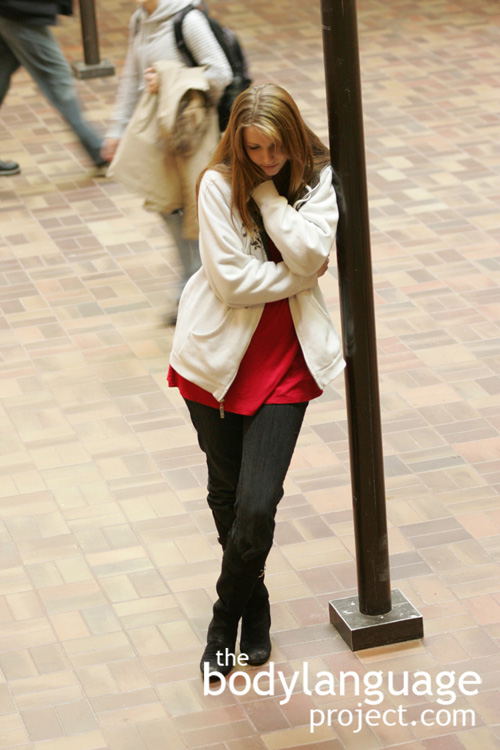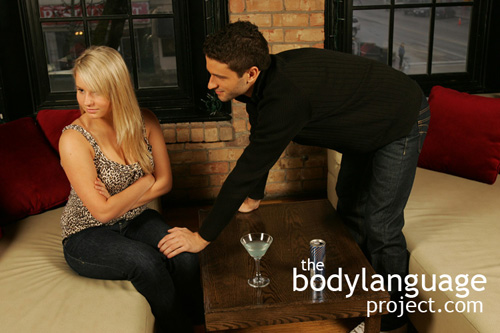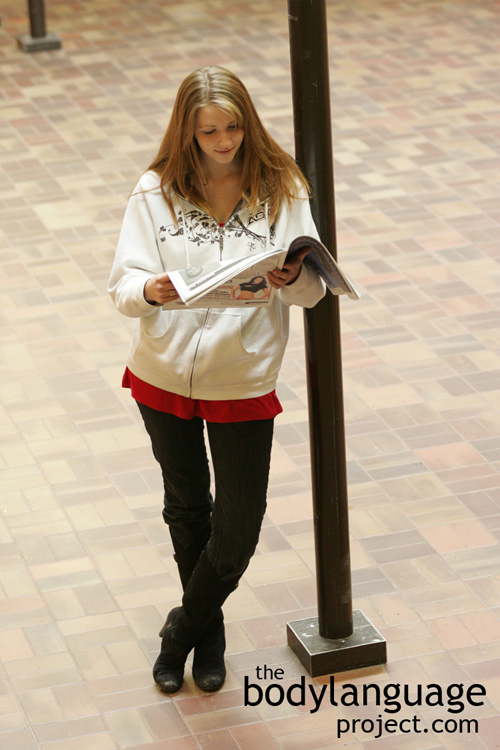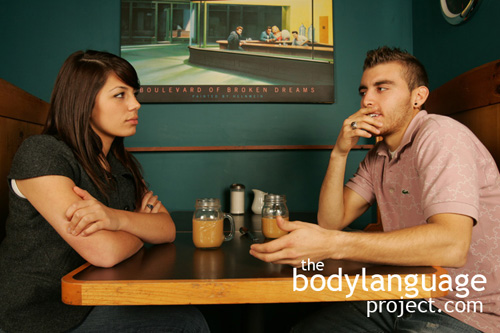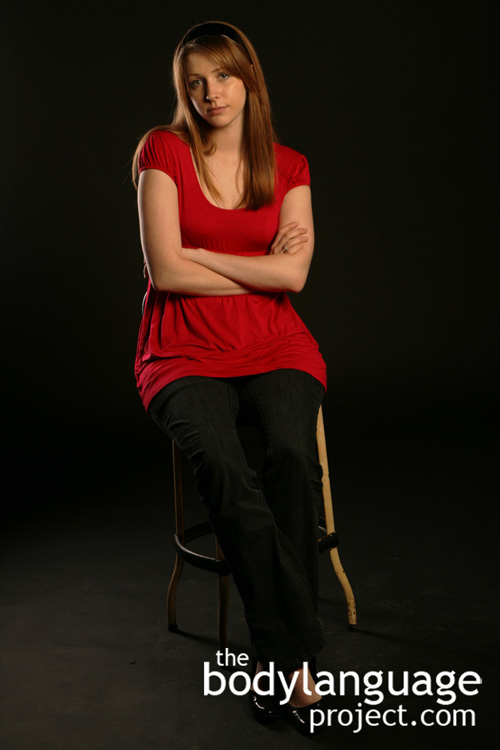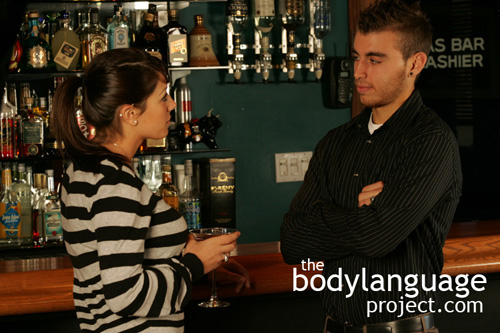Body Language of Crouching
Synonym(s): Cowering
Description: The body takes on a smaller form by bending at the knees or ducking the head.
In One Sentence: Cowering by lowering and taking on a smaller body profile indicates that one desires to submit.
How To Use it: Cower when you want to feel more protected or to ‘hide in plain sight.’ Bringing the chin down, arms in and slumping the shoulders will show others that you are not prepared to battle. More than likely, people will come to your assistance and offer you sympathy and care rather than present further attack. Cowering is best done when you feel that you can not win against another person and instead wish to manipulate their gentle side.
By reducing your profile, you are not only producing a smaller target for attack, but you are also flexing muscles which will help brace against impact. When viewed by an aggressor, cowering is a cue telling him or her than you are not a threat to their dominance and do not wish to challenge them. If read properly by an aggressor, it will lessen their verbal or physical violence.
Context: General.
Verbal Translation: “I’m scared. I’m going to shrink the outline of my body in effort to escape injury or emotional threat.”
Variant: Bow and Body Bend, Body Lowering or Body Shrinking.
Cue In Action: a) A foul ball was coming straight for her so she duck her head down and bent her knees. b) The boss came in looking for trouble so the employees ducked down in their cubicles so they wouldn’t attract attention.
Meaning and/or Motivation: Crouching or cowering is a submissive body posture done to reduce confrontation. Crouching out of fear is a universal posture. When scared either due to emotional discomfort of physical fear, our bodies will shrink down to become a smaller target. Instinctively, people will pull their arms in, tuck their chins down, lower their eyes and otherwise seem to succumb to the effects of gravity.
Making the body smaller is the opposite of defying gravity through expansive movements. It is an indication of confidence and desire in the ability to challenge others.
Cue Cluster: Our heads tuck into our shoulders, our eyes wince and our face scrunches up. Heads can also drop forward to protect the neck from attack and the arms brought up over the chest to protect the heart and lungs. All sorts of crouching takes place over the body and takes on the form of contracted muscles pulling on various parts of the body and shrinking up. When bodies are un-crouched, they are relaxed and loose.
Body Language Category: Body size reduction, Closed body language, Defensive, Distancing or moving away, Escape movements, Fearful body language, Orienting reflex or orienting response, Protective reflexes, Submissive body language.
Resources:
Aviezer H, Trope Y, Todorov A. Body cues, not facial expressions, discriminate between intense positive and negative emotions. Science 2012;338:1225–9.
Allen, Jill; Sarah J. Gervais and Jessi L. Smith. Sit Big to Eat Big: The Interaction of Body Posture and Body Concern on Restrained Eating. Psychology of Women Quarterly 2013. 37(3): 325-336. DOI: 10.1177/0361684313476477pwq.sagepub.com
http://bodylanguageproject.com/articles/sit-big-to-eat-big-how-constrictive-postures-reduce-food-consumption/
Blidstein, Gerald J. The Nonverbal Language of Prayer (review).Shofar: An Interdisciplinary Journal of Jewish Studies. 2007 25(2): 195-196.
Brin, Pablo and Oli Richard. Body Posture Effects On Self-Evaluation: A self-Validation Approach. European Journal of Social Psychology. 2009; 39: 1053–1064.
Boyson, A. R., Pryor, B., & Butler, J. (1999). Height as power in women. North American Journal of Psychology, 1, 109–114.
Burgoon, J. K., & Hoobler, G. (2002). Nonverbal signals. In M. L. Knapp & J. A. Daly (Eds.), Handbook of interpersonal communication (3rd ed., pp. 240–299). Thousand Oaks, CA: Sage.
Burgoon, J. K., Johnson, M. L., & Koch, P. T. (1998). The nature and measurement of interpersonal dominance. Communication Monographs, 65, 308–335.
Cunha, U. ; Leduc, M. ; Nayak, U.S.L. ; Isaacs, B.. Why do old people stoop? Archives of Gerontology and Geriatrics. 1987 6(4): 363-369.
Cashdan, Elizabeth. Smiles, Speech, and Body Posture: How Women and Men Display Sociometric Status and Power. Journal of Nonverbal Behavior. 1998. 22(4): 209-228.
Carney, D. R., Hall, J. A., & LeBeau, L. S. (2005). Beliefs about the nonverbal expression of social power. Journal of Nonverbal Behavior, 29, 105–123.
Darwin, Charles (1872). The Expression of the Emotions in Man and Animals, third edition (New York: Oxford University Press, 1998).
Dunn, Cynthia Dickel. Speaking politely, kindly, and beautifully: ideologies of politeness in Japanese business etiquette training. Multilingua: Journal of Cross-Cultural and Interlanguage Communication. 2013. 32(2): 225(21).
Ellis, L. (1994). The high and the mighty among man and beast: How universal is the relationship between height (or body size) and social status? In L. Ellis (Ed.). Social stratification and socioeconomic inequality (Vol. 2, pp. 93–111). Westport, CT: Praeger Publishers.
Ginsburg, Harvey J. ; Pollman, Vicki A. ; Wauson, Mitzi S. Odom, Richard D. (editor). An ethological analysis of nonverbal inhibitors of aggressive behavior in male elementary school children. Developmental Psychology. 1977 13(4): 417-418.
Geisser M, Robinson M, Keefe F, Weiner M. Catastrophizing, depression and the sensory, affective and evaluative aspects of chronic pain. PAIN. 1994;59:79–83.
Katza, Carmit; Irit Hershkowitz; Lindsay C. Malloya; Michael E. Lamba; Armita Atabakia and Sabine Spindlera. Non-Verbal Behavior of Children Who Disclose or do not Disclose Child Abuse in Investigative Interviews. Child Abuse & Neglect. 2012. 36: 12-20.
http://bodylanguageproject.com/articles/reading-nonverbal-behaviour-child-abuse-cases-encourage-children-divulge-information-truth-telling
Krumhuber, Eva ; Manstead, Antony ; Kappas, Arvid. Temporal Aspects of Facial Displays in Person and Expression Perception: The Effects of Smile Dynamics, Head-tilt, and Gender. Journal of Nonverbal Behavior. 2007. (1): 39-56
Kimbrell, G. Relationship of the upright agonistic posture in the foot shock situation to dominance-submission in male C57BL/6 mice. Psychonomic Science. 1969. 16(3): 167-168.
Martens, Jason P.; Jessica L. Tracy and Azim F. Shariff. Status signals: Adaptive
benefits of displaying and observing the nonverbal expressions of pride and shame, Cognition & Emotion. 2012. 26(3): 390-406. DOI: 10.1080/02699931.2011.645281
http://bodylanguageproject.com/articles/significant-nonverbal-expression-pride-shame-body-language-detailed-examination-origin-function/
Marsh, Abigail A; Henry H. Yu; Julia C. Schechter and R. J. R. Blair. Larger than Life: Humans’ Nonverbal Status Cues Alter Perceived Size. PLoS ONE. 2009. 4(5): e5707. doi:10.1371/journal.pone.0005707.
http://bodylanguageproject.com/articles/large-life-nonverbal-dominance-affects-perception-size/
Marsh, Abigail A; Karina S. Blair; Matthew M. Jones; Niveen Soliman, and R. J. R. Blair. Dominance and Submission: The Ventrolateral Prefrontal Cortex and Responses to Status Cues Journal of Cognitive Neuroscience. 2009. 21:4, pp. 713–724.
Mignault, Alain and Chaudhuri, Avi. The Many Faces of a Neutral Face: Head Tilt and Perception of Dominance and Emotion. Journal of Nonverbal Behavior. 2003 27(2): 111-132.
Meier, B. P., Hauser, D. J., Robinson, M. D., Friesen, C. K., & Schjeldahl, K. (2007b). What’s ‘up’ with God?: Vertical space as a representation of the divine. Journal of Personality and Social Psychology, 93, 699–710.
Meier, B. P., & Robinson, M. D. (2004). Why the sunny side is up: Associations between affect and vertical position. Psychological Science, 15, 243–247.
Meier, B. P., & Robinson, M. D. (2005). The metaphorical representation of affect. Metaphor and Symbol, 21, 239–257.
Meier, B.P., Robinson, M.D., & Caven, A.J. (in press). Why a big mac is a good mac: Associations between affect and size. Basic and Applied Social Psychology.
Melamed, T. (1992). Personality correlates of physical height. Personality and Individual Differences, 13, 1349–1350.
Middleton, W. C., &Moffett, D. C. (1940). The relation of height and weight measurements to intelligence and to dominance-submission among a group of college freshmen. Research Quarterly of the American Association for Health, Physical Education, and Recreation, 11, 53–59.
Montepare, J. M. (1995). The impact of variations in height on young children’s impressions of men and women. Journal of Nonverbal Behavior, 19, 31–47.
Matsumura, Shuichi ; Hayden, Thomas J. When should signals of submission be given?–A game theory model. Journal of Theoretical Biology. 2006. 240(3): 425-433.
Mehrabian, Albert Deese, James (editor). Significance of posture and position in the communication of attitude and status relationships. Psychological Bulletin. 1969. 71(5): 359-372.
Matsumoto, D., & Willingham, B. (2006). The thrill of victory and the agony of defeat: Spontaneous expressions of medal winners of the 2004 Athens Olympic Games. Journal of Personality and Social Psychology, 91(3), 568–581.
Mouterde, S. C., Duganzich, D. M., Molles, L. E., Helps, S., Helps, R., & Waas, J. R. (2012). Triumph displays inform eavesdropping little blue penguins of new dominance asymmetries. Animal Behaviour, 83, 605–611.
Oosterwijk, Suzanne; Mark Rotteveel; Agneta H. Fischer and Ursula Hess. Embodied Emotion Concepts: How Generating Words About Pride and Disappointment Influences Posture. European Journal of Social Psychology. 2009. 39: 457–466. DOI: 10.1002/ejsp.584
http://bodylanguageproject.com/articles/embodiment-nonverbal-posture-thinking-pride-shame-literally-changes-body-language/
Navarro, Joe. 2008. What Every BODY is Saying: An Ex-FBI Agent’s Guide to Speed-Reading People. William Morrow Paperbacks.
Pitterman, Hallee ; Nowicki Jr, Stephen. A Test of the Ability to Identify Emotion in Human Standing and Sitting Postures: The Diagnostic Analysis of Nonverbal Accuracy-2 Posture Test (DANVA2-POS). Genetic, Social, and General Psychology Monographs. 2004. 130(2): 146-162.
Park, Lora E.; Lindsey Streamer; Li Huang and Adam D. Galinsky. Stand Tall, But Don’t Put Your Feet Up: Universal and Culturally-Specific Effects of Expansive Postures On Power. Journal of Experimental Social Psychology. 2013; 49: 965–971.
http://bodylanguageproject.com/articles/are-expansive-postures-of-power-universal-or-cultural/
Pablo Briñol; Richard E. Petty and Benjamin Wagner. Body Posture Effects on Self-Evaluation: A Self-Validation Approach. European Journal of Social Psychology. 2009. 39(6): 1099-0992. DOI: 10.1002/ejsp.607. http://dx.doi.org/10.1002/ejsp.607
http://bodylanguageproject.com/articles/fix-posture-fix-confidence/
Prieto, A. G., & Robbins, M. C. (1975). Perceptions of height and self-esteem. Perceptual and Motor Skills, 40, 395–398.
Pugh, George E. (1977). The Biological Origin of Human Values (New York: Basic Books).
Robinson, Michael D. ; Zabelina, Darya L. ; Ode, Scott ; Moeller, Sara K. The vertical nature of dominance-submission: Individual differences in vertical attention. Journal of Research in Personality. 2008. 42(4): 933-948.
Rahaman, H., and M. Parthasarathy (1968). “The Expressive Movements of the Bonnet Macaque.” In Primates (Vol. 9), pp. 259-72.
Riskind, John H. Manis, Melvin (editor). They stoop to conquer: Guiding and self-regulatory functions of physical posture after success and failure. Journal of Personality and Social Psychology. 1984 47(3): 479-493.
Rule, Nicholas, O.; Reginald B. Adams Jr.; Nalini Ambady and Jonathan B. Freeman. Perceptions Of Dominance Following Glimpses Of Faces And Bodies. Perception. 2012; 41: 687-706 doi:10.1068/p7023
http://bodylanguageproject.com/articles/people-can-read-dominance-split-second
Scarpa, Stephano; Alessandra Nart; Erica Gobbi and Atillo Carraro. Does Women’s Attitudinal State Body Image Improve After One Session Of Posture Correction Exercises? Social Behavior and Personality. 2011; 39(8): 1045-1052.
Schubert, T. W. (2005). Your highness: Vertical positions as perceptual symbols of power. Journal of Personality and Social Psychology. 89, 1–21.
Schubert, T. W. (2005). Your highness: Vertical positions as perceptual symbols of power. Journal of Personality and Social Psychology, 89, 1–21.
Schwartz, B., Tesser, A., & Powell, E. (1982). Dominance cues in nonverbal behavior. Social Psychology Quarterly, 45, 114–120.
Stepper, S., & Strack, F. (1993). Proprioceptive determinants of emotional and nonemotional feelings. Journal of Personality and Social Psychology, 64, 211–220.
Schenkel, Rudolf. Submission: Its Features and Function in the Wolf and Dog. American Zoologist. 1967. 7(2): 319-329.
Tracy, J. L., & Matsumoto, D. (2008). The spontaneous expression of pride and shame: Evidence for biologically innate nonverbal displays. Proceedings from the National Academy of Sciences, 105(33), 11655–11660.
Tracy, J. L., & Robins, R. W. (2007). The prototypical pride expression: Development of a nonverbal behavior coding system. Emotion, 7(4), 789–801.
Tiedens, Larissa Z ; Fragale, Alison R. Power moves: complementarity in dominant and submissive nonverbal behavior. Journal of personality and social psychology. 2003. 84(3): 558-68.
Tracy, J. L., & Robins, R. W. (2004). Show your pride: Evidence for a discrete emotion expression. Psychological Science, 15, 194–197.
Teixeira Fiquer, Juliana; Paulo Sérgio Boggio and Clarice Gorenstein. Talking Bodies: Nonverbal Behavior in the Assessment of Depression Severity. Journal of Affective Disorders. 2013. 150: 1114-1119.
http://bodylanguageproject.com/articles/using-nonverbal-behaviour-to-assess-depression-severity/
Weisfeld, Glenn E. and Jody M. Beresford. Erectness of Posture as an Indicator of Dominance or Success in Humans. Motivation and Emotion. 1982. 6(2): 113-130.
http://bodylanguageproject.com/articles/body-language-cues-dominance-submission-children/
Welker, Keith M. ; Oberleitner, David E. ; Cain, Samantha ; Carré, Justin M. Upright and left out: Posture moderates the effects of social exclusion on mood and threats to basic needs. European Journal of Social Psychology. 2013 43(5): 355-361.
Weisbuch, Max ; Slepian, Michael L ; Eccleston, Collette P ; Ambady, Nalini. Nonverbal Expressions of Status and System Legitimacy. Psychological Science. 2013. 24(11): 2315-2321.
Walsh, Joseph ; Eccleston, Christopher ; Keogh, Edmund. Pain communication through body posture: The development and validation of a stimulus set. Pain. 2014. 155(11): 2282-2290.


